Palliative Care for Breathlessness in a Patient with Metastatic Breast Cancer and COPD
VerifiedAdded on 2023/01/23
|14
|3311
|61
AI Summary
This article discusses the causes and management of breathlessness in a patient with metastatic breast cancer and COPD, highlighting the importance of palliative care in improving quality of life.
Contribute Materials
Your contribution can guide someone’s learning journey. Share your
documents today.
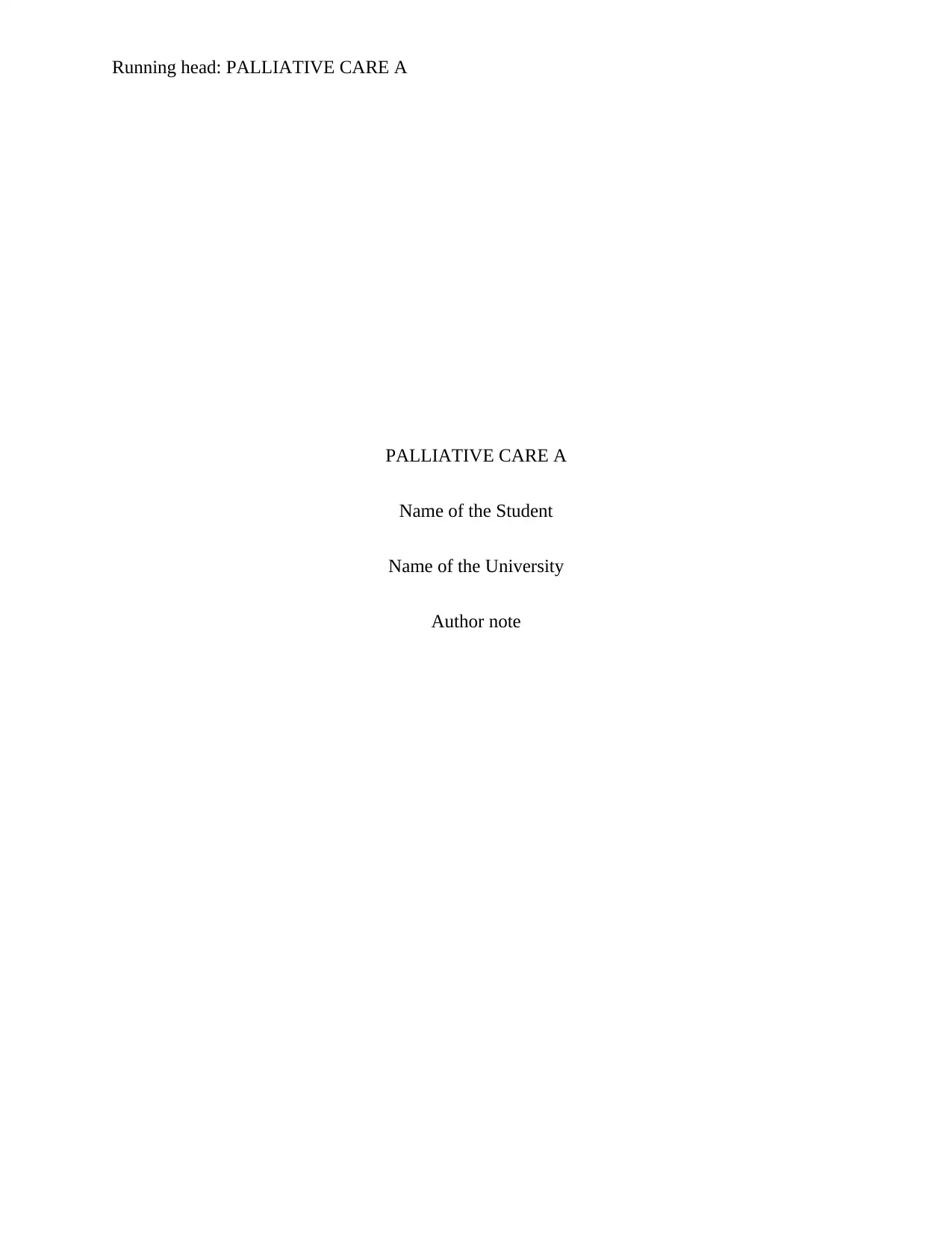
Running head: PALLIATIVE CARE A
PALLIATIVE CARE A
Name of the Student
Name of the University
Author note
PALLIATIVE CARE A
Name of the Student
Name of the University
Author note
Secure Best Marks with AI Grader
Need help grading? Try our AI Grader for instant feedback on your assignments.

1PALLIATIVE CARE A
Table of Contents
Question 1........................................................................................................................................2
Question 2........................................................................................................................................4
Reference.......................................................................................................................................11
Table of Contents
Question 1........................................................................................................................................2
Question 2........................................................................................................................................4
Reference.......................................................................................................................................11
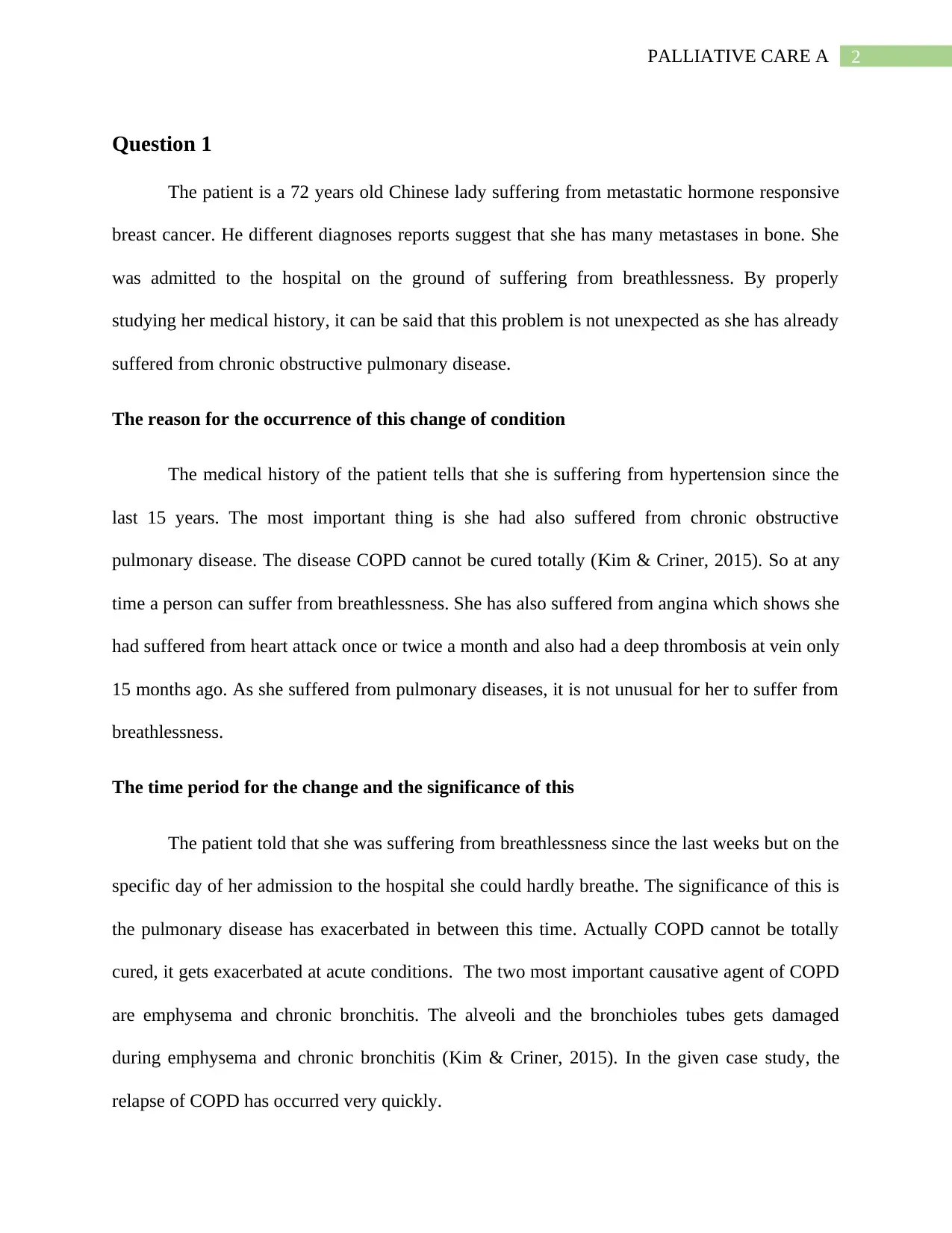
2PALLIATIVE CARE A
Question 1
The patient is a 72 years old Chinese lady suffering from metastatic hormone responsive
breast cancer. He different diagnoses reports suggest that she has many metastases in bone. She
was admitted to the hospital on the ground of suffering from breathlessness. By properly
studying her medical history, it can be said that this problem is not unexpected as she has already
suffered from chronic obstructive pulmonary disease.
The reason for the occurrence of this change of condition
The medical history of the patient tells that she is suffering from hypertension since the
last 15 years. The most important thing is she had also suffered from chronic obstructive
pulmonary disease. The disease COPD cannot be cured totally (Kim & Criner, 2015). So at any
time a person can suffer from breathlessness. She has also suffered from angina which shows she
had suffered from heart attack once or twice a month and also had a deep thrombosis at vein only
15 months ago. As she suffered from pulmonary diseases, it is not unusual for her to suffer from
breathlessness.
The time period for the change and the significance of this
The patient told that she was suffering from breathlessness since the last weeks but on the
specific day of her admission to the hospital she could hardly breathe. The significance of this is
the pulmonary disease has exacerbated in between this time. Actually COPD cannot be totally
cured, it gets exacerbated at acute conditions. The two most important causative agent of COPD
are emphysema and chronic bronchitis. The alveoli and the bronchioles tubes gets damaged
during emphysema and chronic bronchitis (Kim & Criner, 2015). In the given case study, the
relapse of COPD has occurred very quickly.
Question 1
The patient is a 72 years old Chinese lady suffering from metastatic hormone responsive
breast cancer. He different diagnoses reports suggest that she has many metastases in bone. She
was admitted to the hospital on the ground of suffering from breathlessness. By properly
studying her medical history, it can be said that this problem is not unexpected as she has already
suffered from chronic obstructive pulmonary disease.
The reason for the occurrence of this change of condition
The medical history of the patient tells that she is suffering from hypertension since the
last 15 years. The most important thing is she had also suffered from chronic obstructive
pulmonary disease. The disease COPD cannot be cured totally (Kim & Criner, 2015). So at any
time a person can suffer from breathlessness. She has also suffered from angina which shows she
had suffered from heart attack once or twice a month and also had a deep thrombosis at vein only
15 months ago. As she suffered from pulmonary diseases, it is not unusual for her to suffer from
breathlessness.
The time period for the change and the significance of this
The patient told that she was suffering from breathlessness since the last weeks but on the
specific day of her admission to the hospital she could hardly breathe. The significance of this is
the pulmonary disease has exacerbated in between this time. Actually COPD cannot be totally
cured, it gets exacerbated at acute conditions. The two most important causative agent of COPD
are emphysema and chronic bronchitis. The alveoli and the bronchioles tubes gets damaged
during emphysema and chronic bronchitis (Kim & Criner, 2015). In the given case study, the
relapse of COPD has occurred very quickly.
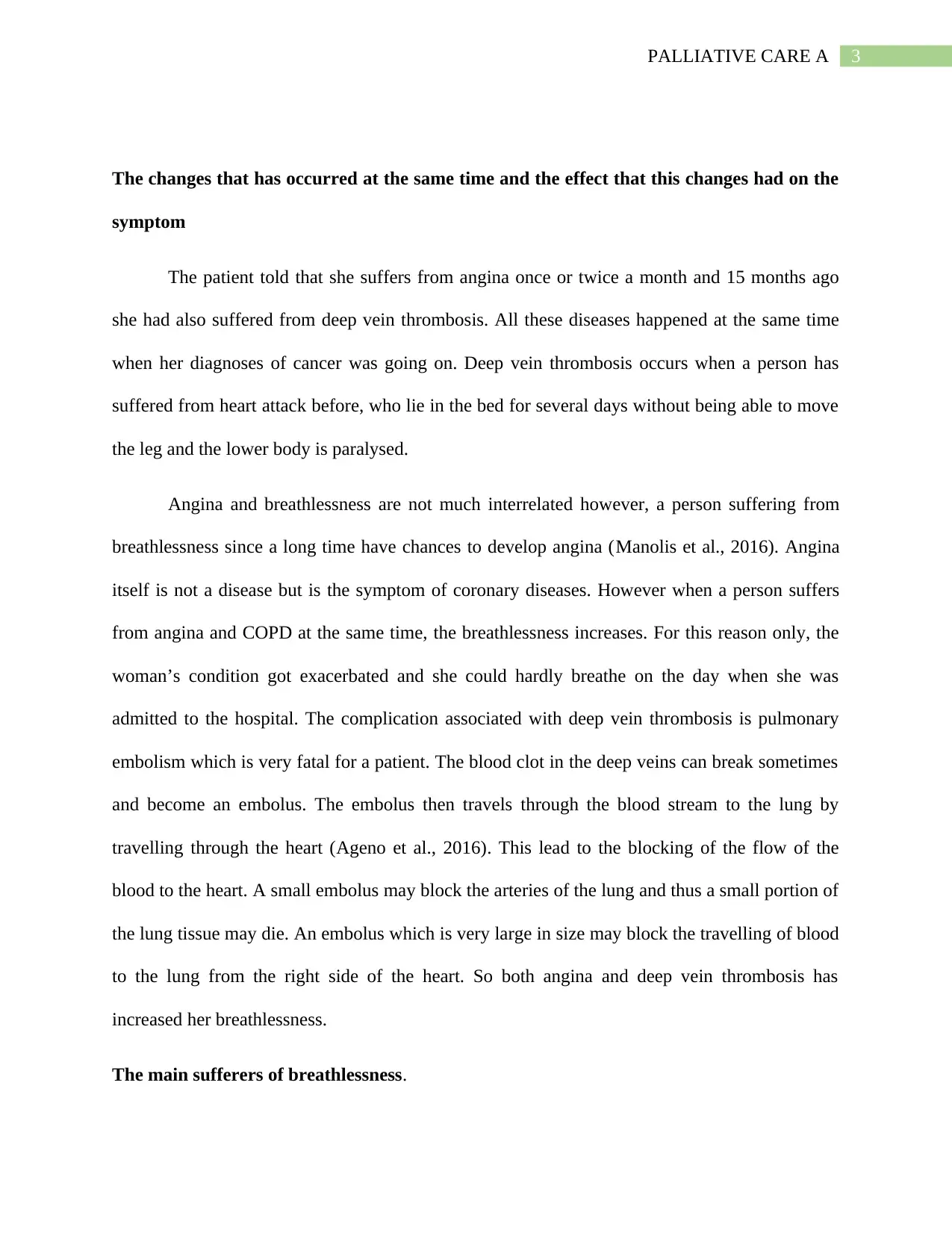
3PALLIATIVE CARE A
The changes that has occurred at the same time and the effect that this changes had on the
symptom
The patient told that she suffers from angina once or twice a month and 15 months ago
she had also suffered from deep vein thrombosis. All these diseases happened at the same time
when her diagnoses of cancer was going on. Deep vein thrombosis occurs when a person has
suffered from heart attack before, who lie in the bed for several days without being able to move
the leg and the lower body is paralysed.
Angina and breathlessness are not much interrelated however, a person suffering from
breathlessness since a long time have chances to develop angina (Manolis et al., 2016). Angina
itself is not a disease but is the symptom of coronary diseases. However when a person suffers
from angina and COPD at the same time, the breathlessness increases. For this reason only, the
woman’s condition got exacerbated and she could hardly breathe on the day when she was
admitted to the hospital. The complication associated with deep vein thrombosis is pulmonary
embolism which is very fatal for a patient. The blood clot in the deep veins can break sometimes
and become an embolus. The embolus then travels through the blood stream to the lung by
travelling through the heart (Ageno et al., 2016). This lead to the blocking of the flow of the
blood to the heart. A small embolus may block the arteries of the lung and thus a small portion of
the lung tissue may die. An embolus which is very large in size may block the travelling of blood
to the lung from the right side of the heart. So both angina and deep vein thrombosis has
increased her breathlessness.
The main sufferers of breathlessness.
The changes that has occurred at the same time and the effect that this changes had on the
symptom
The patient told that she suffers from angina once or twice a month and 15 months ago
she had also suffered from deep vein thrombosis. All these diseases happened at the same time
when her diagnoses of cancer was going on. Deep vein thrombosis occurs when a person has
suffered from heart attack before, who lie in the bed for several days without being able to move
the leg and the lower body is paralysed.
Angina and breathlessness are not much interrelated however, a person suffering from
breathlessness since a long time have chances to develop angina (Manolis et al., 2016). Angina
itself is not a disease but is the symptom of coronary diseases. However when a person suffers
from angina and COPD at the same time, the breathlessness increases. For this reason only, the
woman’s condition got exacerbated and she could hardly breathe on the day when she was
admitted to the hospital. The complication associated with deep vein thrombosis is pulmonary
embolism which is very fatal for a patient. The blood clot in the deep veins can break sometimes
and become an embolus. The embolus then travels through the blood stream to the lung by
travelling through the heart (Ageno et al., 2016). This lead to the blocking of the flow of the
blood to the heart. A small embolus may block the arteries of the lung and thus a small portion of
the lung tissue may die. An embolus which is very large in size may block the travelling of blood
to the lung from the right side of the heart. So both angina and deep vein thrombosis has
increased her breathlessness.
The main sufferers of breathlessness.
Secure Best Marks with AI Grader
Need help grading? Try our AI Grader for instant feedback on your assignments.
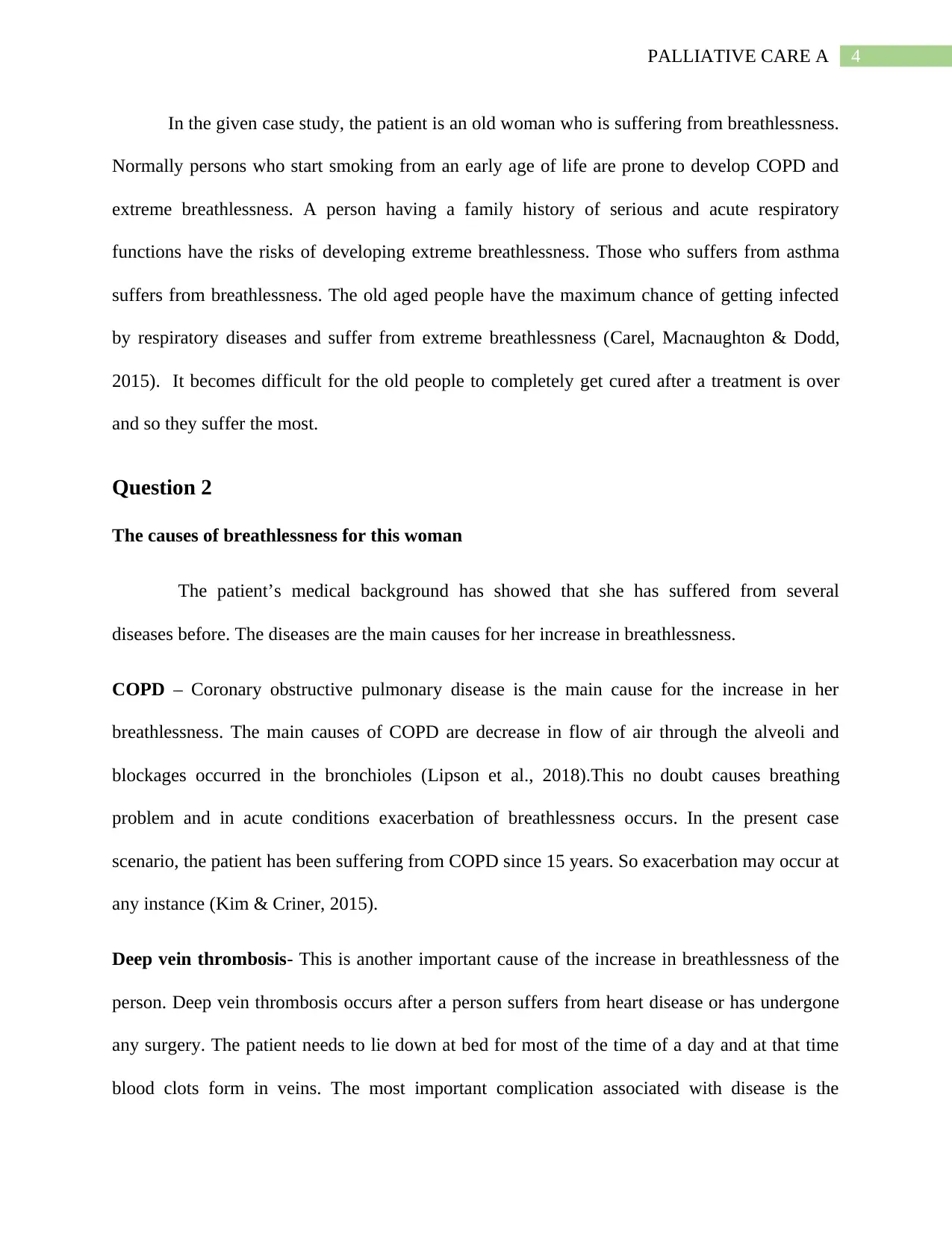
4PALLIATIVE CARE A
In the given case study, the patient is an old woman who is suffering from breathlessness.
Normally persons who start smoking from an early age of life are prone to develop COPD and
extreme breathlessness. A person having a family history of serious and acute respiratory
functions have the risks of developing extreme breathlessness. Those who suffers from asthma
suffers from breathlessness. The old aged people have the maximum chance of getting infected
by respiratory diseases and suffer from extreme breathlessness (Carel, Macnaughton & Dodd,
2015). It becomes difficult for the old people to completely get cured after a treatment is over
and so they suffer the most.
Question 2
The causes of breathlessness for this woman
The patient’s medical background has showed that she has suffered from several
diseases before. The diseases are the main causes for her increase in breathlessness.
COPD – Coronary obstructive pulmonary disease is the main cause for the increase in her
breathlessness. The main causes of COPD are decrease in flow of air through the alveoli and
blockages occurred in the bronchioles (Lipson et al., 2018).This no doubt causes breathing
problem and in acute conditions exacerbation of breathlessness occurs. In the present case
scenario, the patient has been suffering from COPD since 15 years. So exacerbation may occur at
any instance (Kim & Criner, 2015).
Deep vein thrombosis- This is another important cause of the increase in breathlessness of the
person. Deep vein thrombosis occurs after a person suffers from heart disease or has undergone
any surgery. The patient needs to lie down at bed for most of the time of a day and at that time
blood clots form in veins. The most important complication associated with disease is the
In the given case study, the patient is an old woman who is suffering from breathlessness.
Normally persons who start smoking from an early age of life are prone to develop COPD and
extreme breathlessness. A person having a family history of serious and acute respiratory
functions have the risks of developing extreme breathlessness. Those who suffers from asthma
suffers from breathlessness. The old aged people have the maximum chance of getting infected
by respiratory diseases and suffer from extreme breathlessness (Carel, Macnaughton & Dodd,
2015). It becomes difficult for the old people to completely get cured after a treatment is over
and so they suffer the most.
Question 2
The causes of breathlessness for this woman
The patient’s medical background has showed that she has suffered from several
diseases before. The diseases are the main causes for her increase in breathlessness.
COPD – Coronary obstructive pulmonary disease is the main cause for the increase in her
breathlessness. The main causes of COPD are decrease in flow of air through the alveoli and
blockages occurred in the bronchioles (Lipson et al., 2018).This no doubt causes breathing
problem and in acute conditions exacerbation of breathlessness occurs. In the present case
scenario, the patient has been suffering from COPD since 15 years. So exacerbation may occur at
any instance (Kim & Criner, 2015).
Deep vein thrombosis- This is another important cause of the increase in breathlessness of the
person. Deep vein thrombosis occurs after a person suffers from heart disease or has undergone
any surgery. The patient needs to lie down at bed for most of the time of a day and at that time
blood clots form in veins. The most important complication associated with disease is the
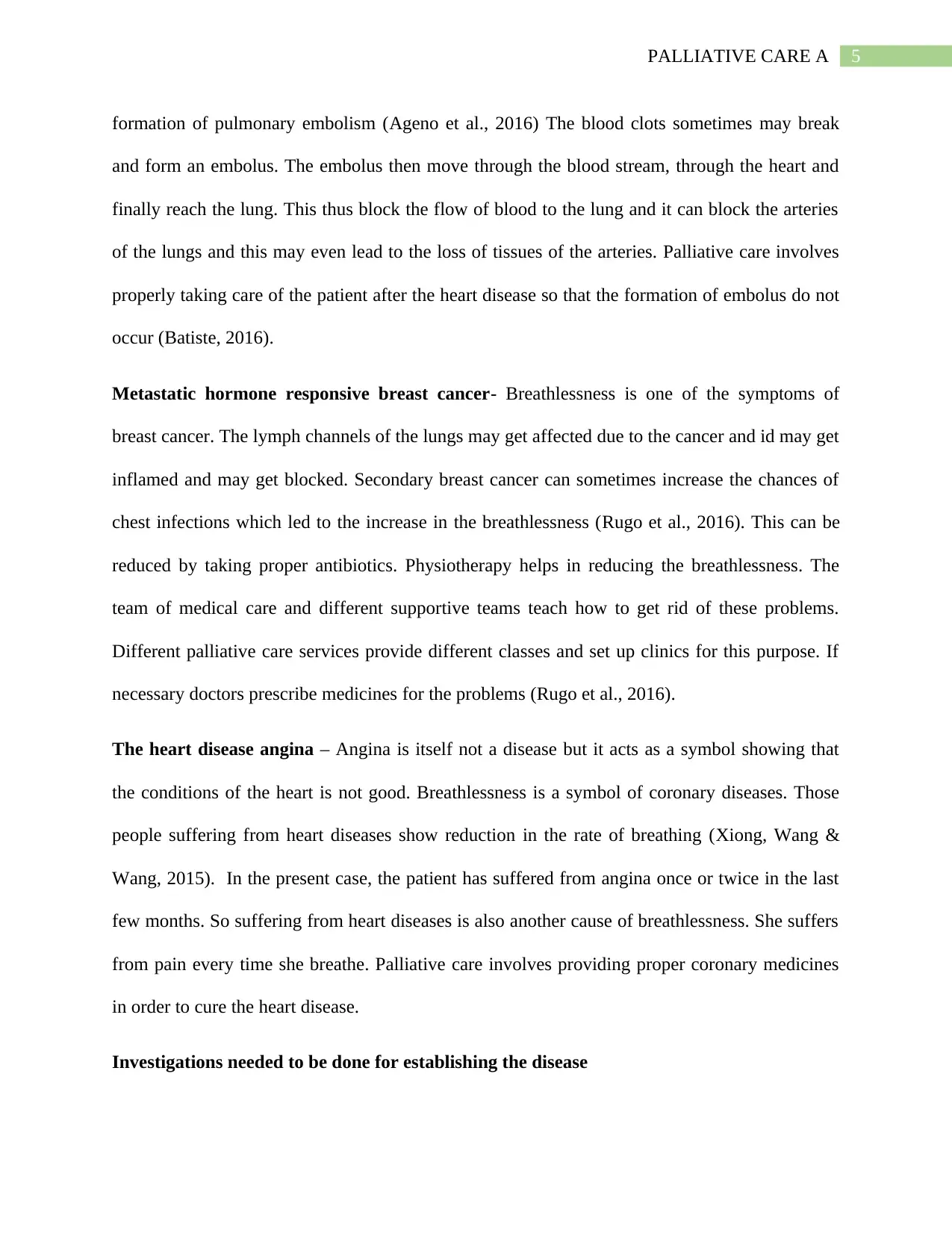
5PALLIATIVE CARE A
formation of pulmonary embolism (Ageno et al., 2016) The blood clots sometimes may break
and form an embolus. The embolus then move through the blood stream, through the heart and
finally reach the lung. This thus block the flow of blood to the lung and it can block the arteries
of the lungs and this may even lead to the loss of tissues of the arteries. Palliative care involves
properly taking care of the patient after the heart disease so that the formation of embolus do not
occur (Batiste, 2016).
Metastatic hormone responsive breast cancer- Breathlessness is one of the symptoms of
breast cancer. The lymph channels of the lungs may get affected due to the cancer and id may get
inflamed and may get blocked. Secondary breast cancer can sometimes increase the chances of
chest infections which led to the increase in the breathlessness (Rugo et al., 2016). This can be
reduced by taking proper antibiotics. Physiotherapy helps in reducing the breathlessness. The
team of medical care and different supportive teams teach how to get rid of these problems.
Different palliative care services provide different classes and set up clinics for this purpose. If
necessary doctors prescribe medicines for the problems (Rugo et al., 2016).
The heart disease angina – Angina is itself not a disease but it acts as a symbol showing that
the conditions of the heart is not good. Breathlessness is a symbol of coronary diseases. Those
people suffering from heart diseases show reduction in the rate of breathing (Xiong, Wang &
Wang, 2015). In the present case, the patient has suffered from angina once or twice in the last
few months. So suffering from heart diseases is also another cause of breathlessness. She suffers
from pain every time she breathe. Palliative care involves providing proper coronary medicines
in order to cure the heart disease.
Investigations needed to be done for establishing the disease
formation of pulmonary embolism (Ageno et al., 2016) The blood clots sometimes may break
and form an embolus. The embolus then move through the blood stream, through the heart and
finally reach the lung. This thus block the flow of blood to the lung and it can block the arteries
of the lungs and this may even lead to the loss of tissues of the arteries. Palliative care involves
properly taking care of the patient after the heart disease so that the formation of embolus do not
occur (Batiste, 2016).
Metastatic hormone responsive breast cancer- Breathlessness is one of the symptoms of
breast cancer. The lymph channels of the lungs may get affected due to the cancer and id may get
inflamed and may get blocked. Secondary breast cancer can sometimes increase the chances of
chest infections which led to the increase in the breathlessness (Rugo et al., 2016). This can be
reduced by taking proper antibiotics. Physiotherapy helps in reducing the breathlessness. The
team of medical care and different supportive teams teach how to get rid of these problems.
Different palliative care services provide different classes and set up clinics for this purpose. If
necessary doctors prescribe medicines for the problems (Rugo et al., 2016).
The heart disease angina – Angina is itself not a disease but it acts as a symbol showing that
the conditions of the heart is not good. Breathlessness is a symbol of coronary diseases. Those
people suffering from heart diseases show reduction in the rate of breathing (Xiong, Wang &
Wang, 2015). In the present case, the patient has suffered from angina once or twice in the last
few months. So suffering from heart diseases is also another cause of breathlessness. She suffers
from pain every time she breathe. Palliative care involves providing proper coronary medicines
in order to cure the heart disease.
Investigations needed to be done for establishing the disease
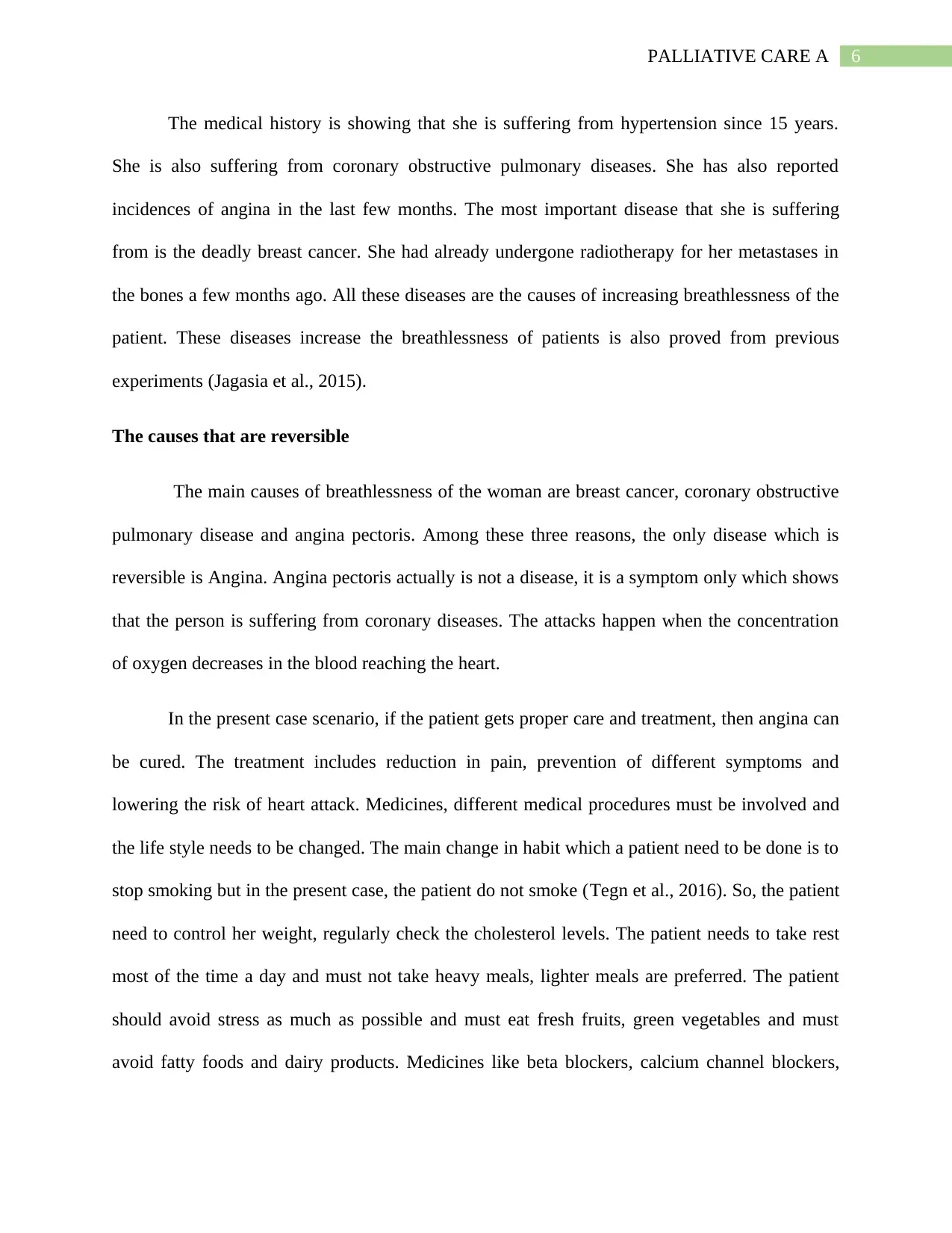
6PALLIATIVE CARE A
The medical history is showing that she is suffering from hypertension since 15 years.
She is also suffering from coronary obstructive pulmonary diseases. She has also reported
incidences of angina in the last few months. The most important disease that she is suffering
from is the deadly breast cancer. She had already undergone radiotherapy for her metastases in
the bones a few months ago. All these diseases are the causes of increasing breathlessness of the
patient. These diseases increase the breathlessness of patients is also proved from previous
experiments (Jagasia et al., 2015).
The causes that are reversible
The main causes of breathlessness of the woman are breast cancer, coronary obstructive
pulmonary disease and angina pectoris. Among these three reasons, the only disease which is
reversible is Angina. Angina pectoris actually is not a disease, it is a symptom only which shows
that the person is suffering from coronary diseases. The attacks happen when the concentration
of oxygen decreases in the blood reaching the heart.
In the present case scenario, if the patient gets proper care and treatment, then angina can
be cured. The treatment includes reduction in pain, prevention of different symptoms and
lowering the risk of heart attack. Medicines, different medical procedures must be involved and
the life style needs to be changed. The main change in habit which a patient need to be done is to
stop smoking but in the present case, the patient do not smoke (Tegn et al., 2016). So, the patient
need to control her weight, regularly check the cholesterol levels. The patient needs to take rest
most of the time a day and must not take heavy meals, lighter meals are preferred. The patient
should avoid stress as much as possible and must eat fresh fruits, green vegetables and must
avoid fatty foods and dairy products. Medicines like beta blockers, calcium channel blockers,
The medical history is showing that she is suffering from hypertension since 15 years.
She is also suffering from coronary obstructive pulmonary diseases. She has also reported
incidences of angina in the last few months. The most important disease that she is suffering
from is the deadly breast cancer. She had already undergone radiotherapy for her metastases in
the bones a few months ago. All these diseases are the causes of increasing breathlessness of the
patient. These diseases increase the breathlessness of patients is also proved from previous
experiments (Jagasia et al., 2015).
The causes that are reversible
The main causes of breathlessness of the woman are breast cancer, coronary obstructive
pulmonary disease and angina pectoris. Among these three reasons, the only disease which is
reversible is Angina. Angina pectoris actually is not a disease, it is a symptom only which shows
that the person is suffering from coronary diseases. The attacks happen when the concentration
of oxygen decreases in the blood reaching the heart.
In the present case scenario, if the patient gets proper care and treatment, then angina can
be cured. The treatment includes reduction in pain, prevention of different symptoms and
lowering the risk of heart attack. Medicines, different medical procedures must be involved and
the life style needs to be changed. The main change in habit which a patient need to be done is to
stop smoking but in the present case, the patient do not smoke (Tegn et al., 2016). So, the patient
need to control her weight, regularly check the cholesterol levels. The patient needs to take rest
most of the time a day and must not take heavy meals, lighter meals are preferred. The patient
should avoid stress as much as possible and must eat fresh fruits, green vegetables and must
avoid fatty foods and dairy products. Medicines like beta blockers, calcium channel blockers,
Paraphrase This Document
Need a fresh take? Get an instant paraphrase of this document with our AI Paraphraser
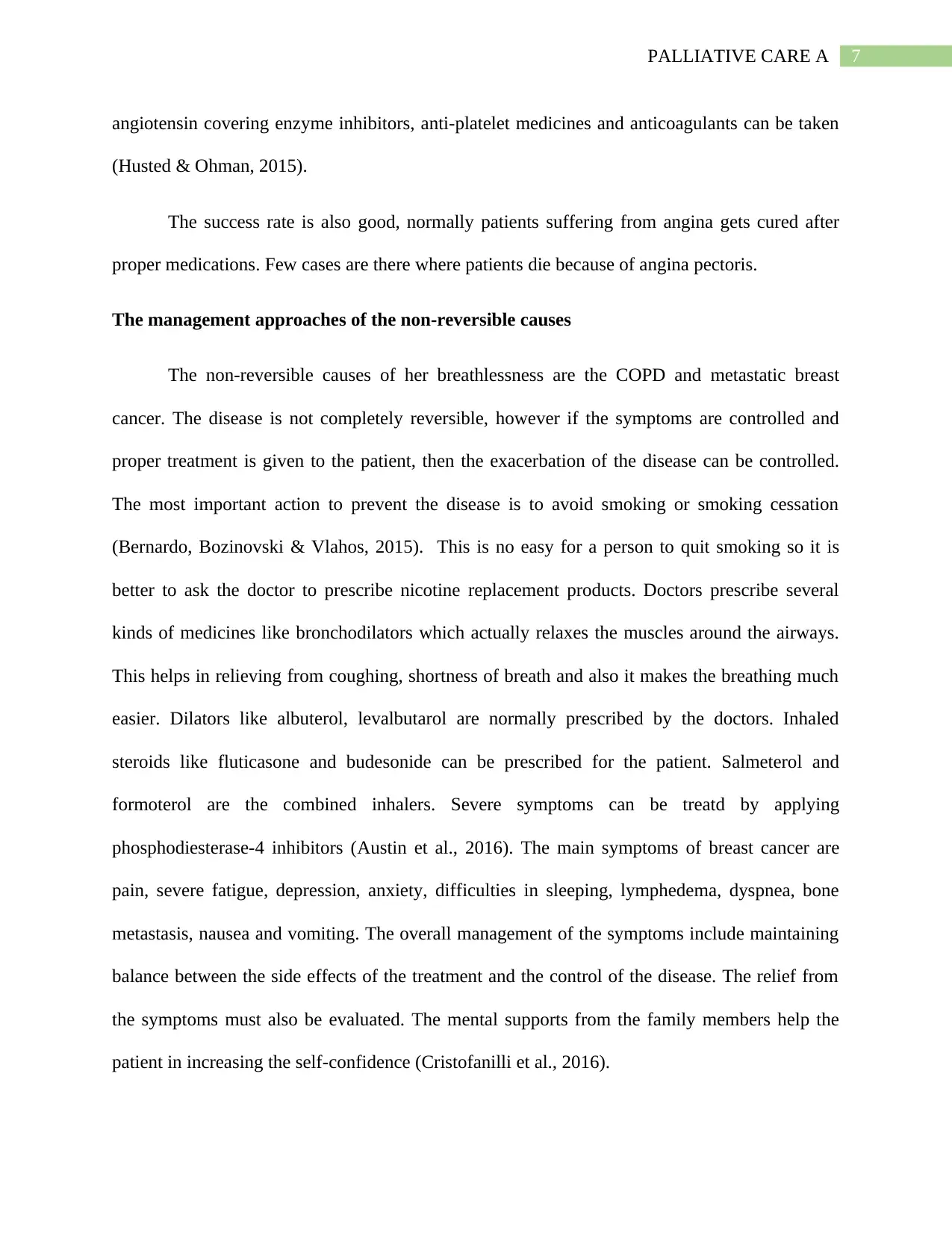
7PALLIATIVE CARE A
angiotensin covering enzyme inhibitors, anti-platelet medicines and anticoagulants can be taken
(Husted & Ohman, 2015).
The success rate is also good, normally patients suffering from angina gets cured after
proper medications. Few cases are there where patients die because of angina pectoris.
The management approaches of the non-reversible causes
The non-reversible causes of her breathlessness are the COPD and metastatic breast
cancer. The disease is not completely reversible, however if the symptoms are controlled and
proper treatment is given to the patient, then the exacerbation of the disease can be controlled.
The most important action to prevent the disease is to avoid smoking or smoking cessation
(Bernardo, Bozinovski & Vlahos, 2015). This is no easy for a person to quit smoking so it is
better to ask the doctor to prescribe nicotine replacement products. Doctors prescribe several
kinds of medicines like bronchodilators which actually relaxes the muscles around the airways.
This helps in relieving from coughing, shortness of breath and also it makes the breathing much
easier. Dilators like albuterol, levalbutarol are normally prescribed by the doctors. Inhaled
steroids like fluticasone and budesonide can be prescribed for the patient. Salmeterol and
formoterol are the combined inhalers. Severe symptoms can be treatd by applying
phosphodiesterase-4 inhibitors (Austin et al., 2016). The main symptoms of breast cancer are
pain, severe fatigue, depression, anxiety, difficulties in sleeping, lymphedema, dyspnea, bone
metastasis, nausea and vomiting. The overall management of the symptoms include maintaining
balance between the side effects of the treatment and the control of the disease. The relief from
the symptoms must also be evaluated. The mental supports from the family members help the
patient in increasing the self-confidence (Cristofanilli et al., 2016).
angiotensin covering enzyme inhibitors, anti-platelet medicines and anticoagulants can be taken
(Husted & Ohman, 2015).
The success rate is also good, normally patients suffering from angina gets cured after
proper medications. Few cases are there where patients die because of angina pectoris.
The management approaches of the non-reversible causes
The non-reversible causes of her breathlessness are the COPD and metastatic breast
cancer. The disease is not completely reversible, however if the symptoms are controlled and
proper treatment is given to the patient, then the exacerbation of the disease can be controlled.
The most important action to prevent the disease is to avoid smoking or smoking cessation
(Bernardo, Bozinovski & Vlahos, 2015). This is no easy for a person to quit smoking so it is
better to ask the doctor to prescribe nicotine replacement products. Doctors prescribe several
kinds of medicines like bronchodilators which actually relaxes the muscles around the airways.
This helps in relieving from coughing, shortness of breath and also it makes the breathing much
easier. Dilators like albuterol, levalbutarol are normally prescribed by the doctors. Inhaled
steroids like fluticasone and budesonide can be prescribed for the patient. Salmeterol and
formoterol are the combined inhalers. Severe symptoms can be treatd by applying
phosphodiesterase-4 inhibitors (Austin et al., 2016). The main symptoms of breast cancer are
pain, severe fatigue, depression, anxiety, difficulties in sleeping, lymphedema, dyspnea, bone
metastasis, nausea and vomiting. The overall management of the symptoms include maintaining
balance between the side effects of the treatment and the control of the disease. The relief from
the symptoms must also be evaluated. The mental supports from the family members help the
patient in increasing the self-confidence (Cristofanilli et al., 2016).
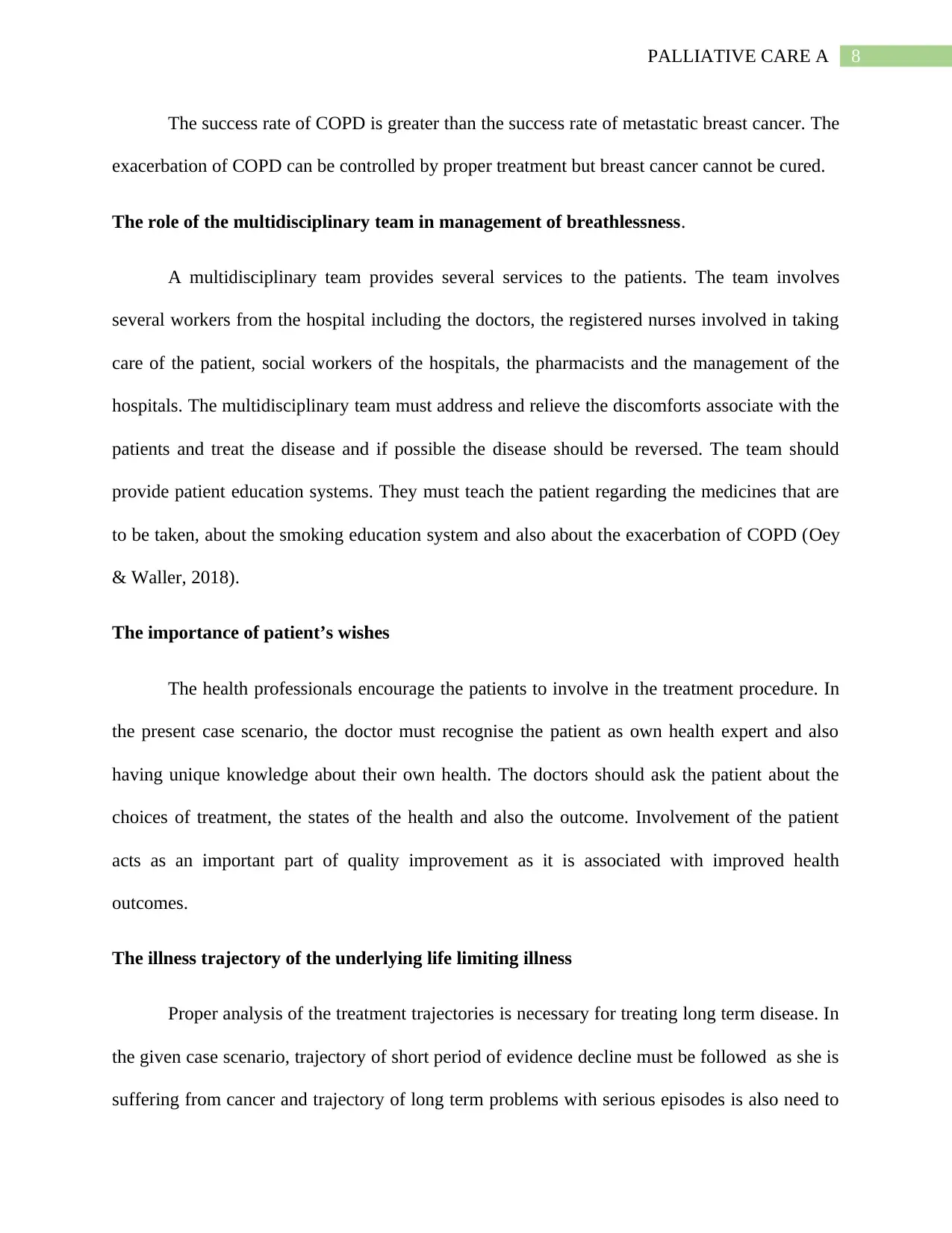
8PALLIATIVE CARE A
The success rate of COPD is greater than the success rate of metastatic breast cancer. The
exacerbation of COPD can be controlled by proper treatment but breast cancer cannot be cured.
The role of the multidisciplinary team in management of breathlessness.
A multidisciplinary team provides several services to the patients. The team involves
several workers from the hospital including the doctors, the registered nurses involved in taking
care of the patient, social workers of the hospitals, the pharmacists and the management of the
hospitals. The multidisciplinary team must address and relieve the discomforts associate with the
patients and treat the disease and if possible the disease should be reversed. The team should
provide patient education systems. They must teach the patient regarding the medicines that are
to be taken, about the smoking education system and also about the exacerbation of COPD (Oey
& Waller, 2018).
The importance of patient’s wishes
The health professionals encourage the patients to involve in the treatment procedure. In
the present case scenario, the doctor must recognise the patient as own health expert and also
having unique knowledge about their own health. The doctors should ask the patient about the
choices of treatment, the states of the health and also the outcome. Involvement of the patient
acts as an important part of quality improvement as it is associated with improved health
outcomes.
The illness trajectory of the underlying life limiting illness
Proper analysis of the treatment trajectories is necessary for treating long term disease. In
the given case scenario, trajectory of short period of evidence decline must be followed as she is
suffering from cancer and trajectory of long term problems with serious episodes is also need to
The success rate of COPD is greater than the success rate of metastatic breast cancer. The
exacerbation of COPD can be controlled by proper treatment but breast cancer cannot be cured.
The role of the multidisciplinary team in management of breathlessness.
A multidisciplinary team provides several services to the patients. The team involves
several workers from the hospital including the doctors, the registered nurses involved in taking
care of the patient, social workers of the hospitals, the pharmacists and the management of the
hospitals. The multidisciplinary team must address and relieve the discomforts associate with the
patients and treat the disease and if possible the disease should be reversed. The team should
provide patient education systems. They must teach the patient regarding the medicines that are
to be taken, about the smoking education system and also about the exacerbation of COPD (Oey
& Waller, 2018).
The importance of patient’s wishes
The health professionals encourage the patients to involve in the treatment procedure. In
the present case scenario, the doctor must recognise the patient as own health expert and also
having unique knowledge about their own health. The doctors should ask the patient about the
choices of treatment, the states of the health and also the outcome. Involvement of the patient
acts as an important part of quality improvement as it is associated with improved health
outcomes.
The illness trajectory of the underlying life limiting illness
Proper analysis of the treatment trajectories is necessary for treating long term disease. In
the given case scenario, trajectory of short period of evidence decline must be followed as she is
suffering from cancer and trajectory of long term problems with serious episodes is also need to

9PALLIATIVE CARE A
be followed as she is suffering from COPD since a long time and also angina pectoris (Cohen et
al., 2017). By following these two trajectories in details, the life limiting illness can be treated in
this case.
be followed as she is suffering from COPD since a long time and also angina pectoris (Cohen et
al., 2017). By following these two trajectories in details, the life limiting illness can be treated in
this case.
Secure Best Marks with AI Grader
Need help grading? Try our AI Grader for instant feedback on your assignments.

10PALLIATIVE CARE A

11PALLIATIVE CARE A
Reference
Ageno, W., Mantovani, L. G., Haas, S., Kreutz, R., Monje, D., Schneider, J., ... & Turpie, A. G.
(2016). Safety and effectiveness of oral rivaroxaban versus standard anticoagulation for
the treatment of symptomatic deep-vein thrombosis (XALIA): an international,
prospective, non-interventional study. The Lancet Haematology, 3(1), e12-e21.
Austin, V., Crack, P. J., Bozinovski, S., Miller, A. A., & Vlahos, R. (2016). COPD and stroke:
are systemic inflammation and oxidative stress the missing links?. Clinical
Science, 130(13), 1039-1050.
Batiste, S. (2016). U.S. Patent No. 9,387,062. Washington, DC: U.S. Patent and Trademark
Office.
Bernardo, I., Bozinovski, S., & Vlahos, R. (2015). Targeting oxidant-dependent mechanisms for
the treatment of COPD and its comorbidities. Pharmacology & therapeutics, 155, 60-79.
Carel, H., Macnaughton, J., & Dodd, J. (2015). Invisible suffering: breathlessness in and beyond
the clinic. The Lancet Respiratory Medicine, 3(4), 278-279.
Cohen, J., Beernaert, K., Van den Block, L., Morin, L., Hunt, K., Miccinesi, G., ... & Wilson, D.
M. (2017). Differences in place of death between lung cancer and COPD patients: a 14-
country study using death certificate data. NPJ primary care respiratory medicine, 27(1),
14.
Cristofanilli, M., Turner, N. C., Bondarenko, I., Ro, J., Im, S. A., Masuda, N., ... & Iwata, H.
(2016). Fulvestrant plus palbociclib versus fulvestrant plus placebo for treatment of
hormone-receptor-positive, HER2-negative metastatic breast cancer that progressed on
Reference
Ageno, W., Mantovani, L. G., Haas, S., Kreutz, R., Monje, D., Schneider, J., ... & Turpie, A. G.
(2016). Safety and effectiveness of oral rivaroxaban versus standard anticoagulation for
the treatment of symptomatic deep-vein thrombosis (XALIA): an international,
prospective, non-interventional study. The Lancet Haematology, 3(1), e12-e21.
Austin, V., Crack, P. J., Bozinovski, S., Miller, A. A., & Vlahos, R. (2016). COPD and stroke:
are systemic inflammation and oxidative stress the missing links?. Clinical
Science, 130(13), 1039-1050.
Batiste, S. (2016). U.S. Patent No. 9,387,062. Washington, DC: U.S. Patent and Trademark
Office.
Bernardo, I., Bozinovski, S., & Vlahos, R. (2015). Targeting oxidant-dependent mechanisms for
the treatment of COPD and its comorbidities. Pharmacology & therapeutics, 155, 60-79.
Carel, H., Macnaughton, J., & Dodd, J. (2015). Invisible suffering: breathlessness in and beyond
the clinic. The Lancet Respiratory Medicine, 3(4), 278-279.
Cohen, J., Beernaert, K., Van den Block, L., Morin, L., Hunt, K., Miccinesi, G., ... & Wilson, D.
M. (2017). Differences in place of death between lung cancer and COPD patients: a 14-
country study using death certificate data. NPJ primary care respiratory medicine, 27(1),
14.
Cristofanilli, M., Turner, N. C., Bondarenko, I., Ro, J., Im, S. A., Masuda, N., ... & Iwata, H.
(2016). Fulvestrant plus palbociclib versus fulvestrant plus placebo for treatment of
hormone-receptor-positive, HER2-negative metastatic breast cancer that progressed on
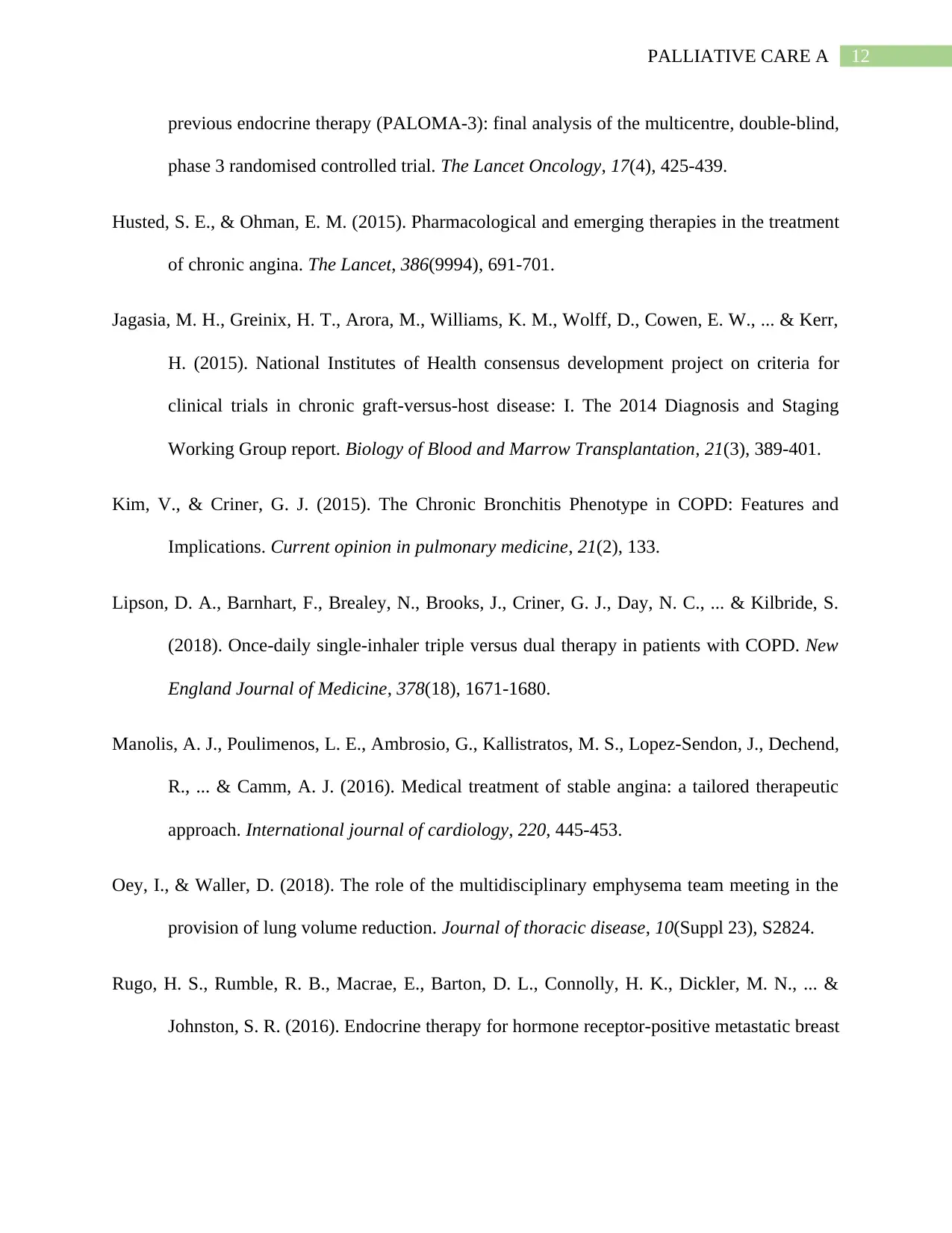
12PALLIATIVE CARE A
previous endocrine therapy (PALOMA-3): final analysis of the multicentre, double-blind,
phase 3 randomised controlled trial. The Lancet Oncology, 17(4), 425-439.
Husted, S. E., & Ohman, E. M. (2015). Pharmacological and emerging therapies in the treatment
of chronic angina. The Lancet, 386(9994), 691-701.
Jagasia, M. H., Greinix, H. T., Arora, M., Williams, K. M., Wolff, D., Cowen, E. W., ... & Kerr,
H. (2015). National Institutes of Health consensus development project on criteria for
clinical trials in chronic graft-versus-host disease: I. The 2014 Diagnosis and Staging
Working Group report. Biology of Blood and Marrow Transplantation, 21(3), 389-401.
Kim, V., & Criner, G. J. (2015). The Chronic Bronchitis Phenotype in COPD: Features and
Implications. Current opinion in pulmonary medicine, 21(2), 133.
Lipson, D. A., Barnhart, F., Brealey, N., Brooks, J., Criner, G. J., Day, N. C., ... & Kilbride, S.
(2018). Once-daily single-inhaler triple versus dual therapy in patients with COPD. New
England Journal of Medicine, 378(18), 1671-1680.
Manolis, A. J., Poulimenos, L. E., Ambrosio, G., Kallistratos, M. S., Lopez-Sendon, J., Dechend,
R., ... & Camm, A. J. (2016). Medical treatment of stable angina: a tailored therapeutic
approach. International journal of cardiology, 220, 445-453.
Oey, I., & Waller, D. (2018). The role of the multidisciplinary emphysema team meeting in the
provision of lung volume reduction. Journal of thoracic disease, 10(Suppl 23), S2824.
Rugo, H. S., Rumble, R. B., Macrae, E., Barton, D. L., Connolly, H. K., Dickler, M. N., ... &
Johnston, S. R. (2016). Endocrine therapy for hormone receptor-positive metastatic breast
previous endocrine therapy (PALOMA-3): final analysis of the multicentre, double-blind,
phase 3 randomised controlled trial. The Lancet Oncology, 17(4), 425-439.
Husted, S. E., & Ohman, E. M. (2015). Pharmacological and emerging therapies in the treatment
of chronic angina. The Lancet, 386(9994), 691-701.
Jagasia, M. H., Greinix, H. T., Arora, M., Williams, K. M., Wolff, D., Cowen, E. W., ... & Kerr,
H. (2015). National Institutes of Health consensus development project on criteria for
clinical trials in chronic graft-versus-host disease: I. The 2014 Diagnosis and Staging
Working Group report. Biology of Blood and Marrow Transplantation, 21(3), 389-401.
Kim, V., & Criner, G. J. (2015). The Chronic Bronchitis Phenotype in COPD: Features and
Implications. Current opinion in pulmonary medicine, 21(2), 133.
Lipson, D. A., Barnhart, F., Brealey, N., Brooks, J., Criner, G. J., Day, N. C., ... & Kilbride, S.
(2018). Once-daily single-inhaler triple versus dual therapy in patients with COPD. New
England Journal of Medicine, 378(18), 1671-1680.
Manolis, A. J., Poulimenos, L. E., Ambrosio, G., Kallistratos, M. S., Lopez-Sendon, J., Dechend,
R., ... & Camm, A. J. (2016). Medical treatment of stable angina: a tailored therapeutic
approach. International journal of cardiology, 220, 445-453.
Oey, I., & Waller, D. (2018). The role of the multidisciplinary emphysema team meeting in the
provision of lung volume reduction. Journal of thoracic disease, 10(Suppl 23), S2824.
Rugo, H. S., Rumble, R. B., Macrae, E., Barton, D. L., Connolly, H. K., Dickler, M. N., ... &
Johnston, S. R. (2016). Endocrine therapy for hormone receptor-positive metastatic breast
Paraphrase This Document
Need a fresh take? Get an instant paraphrase of this document with our AI Paraphraser
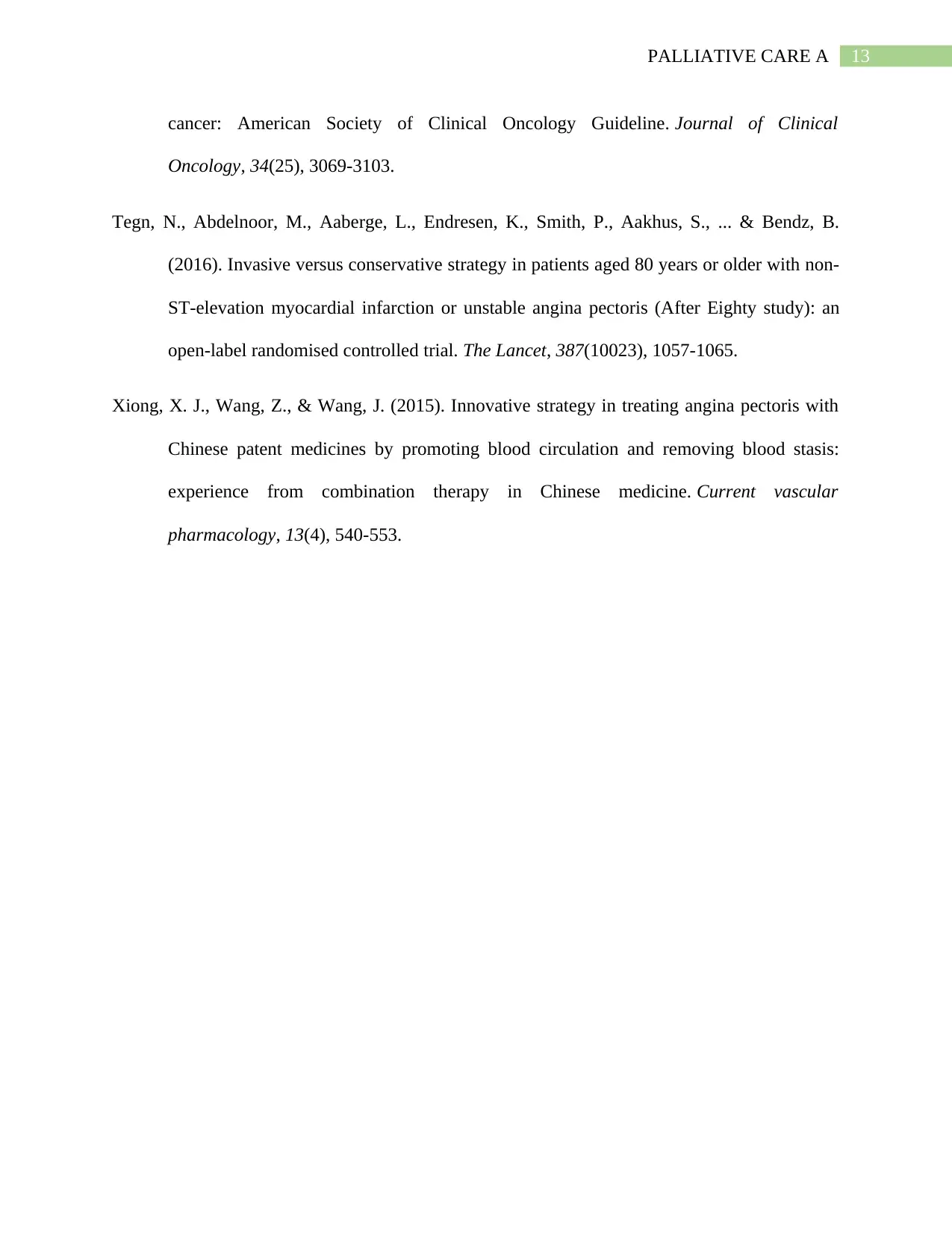
13PALLIATIVE CARE A
cancer: American Society of Clinical Oncology Guideline. Journal of Clinical
Oncology, 34(25), 3069-3103.
Tegn, N., Abdelnoor, M., Aaberge, L., Endresen, K., Smith, P., Aakhus, S., ... & Bendz, B.
(2016). Invasive versus conservative strategy in patients aged 80 years or older with non-
ST-elevation myocardial infarction or unstable angina pectoris (After Eighty study): an
open-label randomised controlled trial. The Lancet, 387(10023), 1057-1065.
Xiong, X. J., Wang, Z., & Wang, J. (2015). Innovative strategy in treating angina pectoris with
Chinese patent medicines by promoting blood circulation and removing blood stasis:
experience from combination therapy in Chinese medicine. Current vascular
pharmacology, 13(4), 540-553.
cancer: American Society of Clinical Oncology Guideline. Journal of Clinical
Oncology, 34(25), 3069-3103.
Tegn, N., Abdelnoor, M., Aaberge, L., Endresen, K., Smith, P., Aakhus, S., ... & Bendz, B.
(2016). Invasive versus conservative strategy in patients aged 80 years or older with non-
ST-elevation myocardial infarction or unstable angina pectoris (After Eighty study): an
open-label randomised controlled trial. The Lancet, 387(10023), 1057-1065.
Xiong, X. J., Wang, Z., & Wang, J. (2015). Innovative strategy in treating angina pectoris with
Chinese patent medicines by promoting blood circulation and removing blood stasis:
experience from combination therapy in Chinese medicine. Current vascular
pharmacology, 13(4), 540-553.
1 out of 14
Related Documents
Your All-in-One AI-Powered Toolkit for Academic Success.
+13062052269
info@desklib.com
Available 24*7 on WhatsApp / Email
![[object Object]](/_next/static/media/star-bottom.7253800d.svg)
Unlock your academic potential
© 2024 | Zucol Services PVT LTD | All rights reserved.





